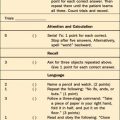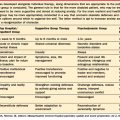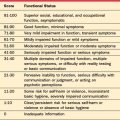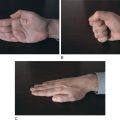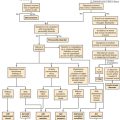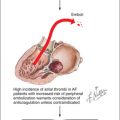CHAPTER 87 Emergency Psychiatry
OVERVIEW
Over the past 20 years, emergency psychiatry has developed into an independent subspecialty practice within consultation-liaison psychiatry. Although formal board certification requirements are lacking, all accredited United States psychiatric residency-training programs follow minimum training guidelines for emergency psychiatry.1 The emergence of emergency psychiatry as a specialized practice parallels the dramatic increase in patient volume in urgent and emergency care settings over the past decade. In 2001, there were over 2 million visits to United States emergency departments (EDs) for mental health–related chief complaints, accounting for more than 6% of all ED visits, and representing an increase in the percentage of all visits by 28% over the previous decade.2 Among emergency mental health visits, substance-related disorders (30%), mood disorders (23%), anxiety disorders (21%), psychosis (10%), and suicide attempts (7%) are the most common.2
Psychiatric emergencies encompass a range of clinical presentations and diagnoses. Typically, such patients seek treatment in a state of crisis, unable to be contained by local support systems. Crises may be understood and addressed from a variety of perspectives, including medical, psychological, interpersonal, and social. Symptoms often consist of an overwhelming mental state that leads to increased dangerousness for that person or for others. Patients may have suicidal or homicidal (violent) ideation, overwhelming depression or anxiety, psychosis, mania, or acute cognitive or behavioral changes. A recent trend has also seen emergency services used for nonemergent conditions.2 Increasing numbers of patients seek treatment at EDs for urgent conditions, routine conditions, or outpatient referrals because of lack of coverage for routine outpatient care, lack of community health care resources, or an inability to access health care.
DEMOGRAPHICS
As of 1991, the United States had about 3,000 dedicated psychiatric emergency services (PESs).3 Among the patients treated at these specialized services, approximately 29% are diagnosed with psychosis, 25% with substance abuse, 23% with major depression, 13% with bipolar disorder, and 22% with personality disorders4; co-morbidity is common. Suicidal ideation is present among approximately one-third to one-half of the patients.3
Though some patients may self-refer to a PES while in crisis, patients may be also be referred by family, friends, general practitioners, medical specialists, mental health treaters in the community, employees of local and state agencies, and staff of airports. Since the occurrence of several school shootings by students, schools in the United States have become a major source of emergency referrals for violence and for suicide assessments.5 Police officers and representatives of the legal system are also a source of referrals, as the PES serves as a conduit between the psychiatric system and the legal system.6 The role of the PES is to help the police identify those patients with psychiatric illness and to re-route them to appropriate care, while those without acute psychiatric illness are returned to the legal system.
TYPES OF DELIVERY MODELS
Two general models are used to deliver emergency psychiatric services. In one model, the PES exists as an independent service, co-located with a general emergency medical service or located separately in a stand-alone facility. In the other model, the PES may function as a consultation service that provides consultation to primary emergency medical services. The model of services offered is determined by the volume of patients and the financial resources available.7
The primary benefit of providing emergency psychiatric services in an area that is separated from the chaos of a busy ED is safety; it provides a more secure environment (e.g., with limited access to sharp or dangerous objects, quiet surroundings to decrease stimulation, individual rooms for private interviews, and the ability to observe and rapidly initiate psychiatric treatment). The unit may also have security staff who are trained to understand mental health issues and who can help to maintain a safe environment. Many units also have specialized rooms for restraint and seclusion.7
Another benefit of a dedicated psychiatric unit is the opportunity to staff the unit with specialized personnel who are trained in emergency psychiatric care.3,7 An interdisciplinary staff of psychiatric residents and attending physicians, nurses, social workers, and case managers can enhance the care of patients with acute illness, for example, by coordinating medical care with colleagues in the ED. Psychiatric nurses also play an important role in triage of mentally ill patients within the psychiatric unit and the ED. Their ability to manage the milieu in an emergency unit, provide individual support to patients, dispense psychiatric medications, and recognize situations that require immediate nursing and physician intervention is invaluable.
Some PESs also have access to “crisis beds” or facilities that are able to provide 24- to 72-hour observation. The ability to observe a patient whose mental state may change significantly after the initiation of antipsychotics or with a period of sobriety may decrease the need for inpatient hospitalization.3,7,8
A PES may also have a mobile crisis team, whose role is to evaluate patients in the community, to diffuse a crisis before a patient is treated at the ED, and to decrease rates of hospitalization. As early as 1980, mobile initial response teams were described as a component of California community mental health centers, and as an alternative to ED care.9 One report from 1990 demonstrated similar hospitalization rates among hospital-based and mobile team emergency interventions,10 whereas more recent reports have demonstrated decreased hospitalization rates associated with use of mobile teams.11–13
THE PSYCHIATRIC INTERVIEW
The cornerstone of the initial psychiatric evaluation is a careful history that focuses on the temporal development of symptoms that have led to the emergency visit, on associated signs and symptoms, and on possible precipitants and causes. In addition, a past history of medical illnesses, psychiatric illnesses, medication usage, allergies, adverse reactions to medications, patterns of substance use, a family history of psychiatric illness, and a psychosocial history serve as important aspects of the initial evaluation. Table 87-1 describes the components of the evaluation and Table 87-2 describes the special features of a substance abuse evaluation.
Table 87-1 The Emergency Psychiatric Interview and Evaluation
Table 87-2 The Substance Abuse Interview
Often, presentations to the PES are complicated and confusing, and patients may be unable, or unwilling, to provide an accurate history. For this reason, an important feature of the evaluation is the collection of history from multiple sources (including family, friends, treaters, police, or emergency personnel who transported the patient). When several informants can be interviewed, data can be corroborated from the various sources, which can help the psychiatrist to make informed disposition decisions.
THE MEDICAL EVALUATION
A medical workup should be considered for any new onset of psychiatric symptomatology or any significant change or exacerbation of symptoms. This initial medical workup is often referred to as “medical clearance.” The term medical clearance generally refers to a medical evaluation aimed at ruling out underlying medical conditions that cause or contribute to a psychiatric presentation. While much attention has been paid to defining a standard for medical clearance, there is no clear consensus regarding the required elements of the medical evaluation.14,15
One retrospective study of 212 consecutive patients who underwent a psychiatric evaluation at an ED demonstrated that among patients with a known psychiatric history and no medical complaints (38%), screening laboratories and radiographic results yielded no additional information; those patients could have been referred for further psychiatric evaluation with the history, the physical examination, and stable vital signs alone. Among the patients deemed to require further medical evaluation (62%), all had either reported medical complaints or their medical histories suggested that further evaluation would be necessary before psychiatric referral.16 Another study of the medical evaluation of ED patients with new-onset psychiatric symptoms (e.g., patients with intoxication with alcohol or drugs, overdoses, and previously diagnosed abnormal behavior were excluded) demonstrated that two-thirds had an organic cause for their psychiatric symptoms.17 These studies suggest that careful screening is important among patients with new-onset symptoms, but additional medical tests may be of little benefit among patients with known psychiatric disorders and without physical complaints or active medical issues.
The medical evaluation should involve a thorough medical history, a general review of systems, and the assessment of vital signs, followed by a physical examination or laboratory tests (or both) as indicated. One should be vigilant of characteristics (such as homelessness or intravenous [IV] drug abuse), which may put a patient at risk for additional medical conditions. The medical tests to consider are listed in Table 87-3.
Table 87-3 Tests to Consider in the Medical Evaluation of Patients with Psychiatric Symptoms
Adapted from Alpay M, Park L: Laboratory tests and diagnostic procedures. In Stern TA, Herman JB, editors: Psychiatry update and board preparation, New York, 2000, McGraw-Hill.
THE SAFETY EVALUATION
The safety evaluation assesses the likelihood that an individual will attempt to harm himself or herself or someone else; it is a mandatory component of every emergency evaluation. With regard to self-harm, the intent may be to harm or to kill oneself (i.e., commit suicide). Suicide is the eighth leading cause of death in the United States, and over 90% of patients who commit suicide have at least one psychiatric diagnosis.18 Patients aged 15 to 24 years and those over age 60 are in the highest-risk groups for suicide.
PSYCHIATRIC SYMPTOMS AND PRESENTATIONS
Diagnosis using DSM-IV criteria19 can be difficult in the PES since patients are seen at a cross section in time, often in the worst crisis of their lives. Although patients will not necessarily fit the criteria exactly, a search for the most common disorders (e.g., mood disorders, psychosis, anxiety disorders, substance abuse, and a change in mental status caused by a medical etiology [delirium]) will facilitate assessment. The following pages will outline some of the most common psychiatric presentations and patient characteristics in the ED.
The Patient with Intoxication or Withdrawal
Alcohol
In more severe cases, alcohol withdrawal can lead to delirium tremens (DTs), which consists of a change in mental status, disorientation, visual hallucinations, and severe autonomic instability. Delirium tremens is a medical emergency with a mortality rate of 5% to 10%; it requires immediate medical care and treatment with IV benzodiazepines, thiamine, and fluids.20
Opiates
Abused opiates seen in the PES include heroin, oxycodone, methadone, hydrocodone, and fentanyl. Intoxication can be identified by drowsiness and by pupillary constriction; in addition, patients describe a sense of euphoria or calm. The greatest risk of opiate overdose is respiratory depression. Frequently, accidental overdoses occur when patients either miscalculate their dose after a period of abstinence (due to decreased tolerance) or when the drug is found to be more pure than is expected. Opiate intoxication can be treated in the emergency setting with naloxone, an opioid antagonist, although drowsiness and respiratory depression may return as the naloxone wears off. In addition, the naloxone will cause an acute and uncomfortable withdrawal syndrome that often leads to agitation on awakening.
Crystal Methamphetamine
Intoxication with crystal methamphetamine and other amphetamines may be recognized by mood lability or irritability, psychomotor agitation, confusion, and sweating. More severe cases may include paranoia, hallucinations, seizures, and fever. Treatment is supportive. Psychotic symptoms can be treated with antipsychotics.21 Withdrawal from amphetamines leads to agitation, irritability, sleep disturbance, psychomotor agitation, and depressed mood.
Phencyclidine
Phencyclidine (PCP; also known as “angel dust”) intoxication is usually heralded in the emergency setting by agitation, paranoia, hallucinations, and violent or bizarre behavior. Intoxication can cause nystagmus, ataxia, and slurred speech; at higher doses it may lead to seizure, hypertensive crisis, coma, and death. Treatment is supportive and should include management in a contained and quiet setting (because of the risk of violence). Antipsychotics, particularly high-potency neuroleptics (such as haloperidol), may be useful. PCP-induced psychosis can last from days to weeks; these patients may require hospitalization if symptoms do not improve within several hours.21 There is no withdrawal syndrome from PCP.
Marijuana
Marijuana is a common drug of abuse among patients treated at the emergency psychiatric service. Symptoms of intoxication include relaxed or elevated mood, alteration in the perception of time, tachycardia, and conjunctival injection.21 Patients may report paranoia or hallucinations, though in these cases, it is important to asses for other drugs of abuse and for underlying psychiatric disorders as well.
The Patient with a Change in Mental Status
When treating a patient who displays a significant change in mental state, it is the task of the emergency psychiatrist to identify the underlying etiology. Generally speaking, changes in mental state represent delirium, dementia, or psychiatric conditions. Because psychiatric conditions are often a diagnosis of exclusion in the acute presentation, delirium and dementia must be ruled out. The Folstein Mini Mental State Examination22 can be useful to screen for cognitive changes. Dementia, a chronic and progressive condition characterized by memory and other cognitive impairments, is discussed elsewhere in this textbook (see Chapter 19).
Delirium, as defined by DSM-IV,19 is a fluctuating state of consciousness and cognition that is caused by a variety of medical conditions. Delirium, also known as acute confusional state or encephalopathy, typically has an acute onset (over hours to days), has a fluctuating course, and is reversible. Disturbance in consciousness, reduced awareness of the environment, attentional difficulties, disorientation, and an inability to think or speak coherently are common symptoms of delirium. Psychomotor agitation is also common, though psychomotor retardation is possible. Symptoms typically associated with psychiatric diagnoses (such as auditory and visual hallucinations, acute changes in mood, and psychotic or disorganized thoughts) may also be seen in delirious states. In general, it can be said that any medical condition can potentially cause any type of alteration in mental state. While certain underlying medical conditions are commonly associated with certain symptoms (e.g., anxiety or agitation with pheochromocytoma, mania with use of corticosteroids, and depression with interferon treatment), the underlying medical condition cannot be diagnosed by its presentation alone; all possible medical conditions must be considered.
Delirium may represent a serious or life-threatening condition. These conditions include Wernicke’s encephalopathy, hypoxia, hypoglycemia, hypertensive encephalopathy, intracerebral hemorrhage, meningitis/encephalitis, poisoning (exogenous or iatrogenic), and seizures. Their assessment and treatment are outlined in Table 87-4. Other, less urgent conditions (including subdural hematoma, septicemia, subacute bacterial endocarditis, hepatic or renal failure, thyrotoxicosis or myxedema, delirium tremens, anticholinergic psychosis, and complex partial status epilepticus) may require acute interventions.23 Once acute causes of delirium have been ruled out, other potential causes of delirium should be considered (see Chapter 18 for a more detailed discussion of delirium). When a medical diagnosis has been made, the primary objective is to address the underlying etiology. Nonetheless, symptomatic treatment of confusion or agitation associated with delirium can be administered.
| Condition | Diagnostics | Treatment |
|---|---|---|
| Wernicke’s encephalopathy | Clinical triad: change in mental status, gait instability, ophthalmoplegia | Thiamine 100 mg IM (may see improvement over the course of hours) |
| Hypoxia | Oxygen saturation/ABGs | Treat etiology |
| Hypoglycemia | Blood glucose | PO/IV administration of glucose, dextrose, sucrose, or fructose |
| Hypertensive encephalopathy | Blood pressure | Antihypertensive medication |
| Hyperthermia/hypothermia | Temperature | Cooling or warming interventions |
| Infectious process (e.g., sepsis, bacteremia, subacute bacterial endocarditis) | Infectious workup | Treat infectious agent/site |
| Intracerebral hemorrhage | MRI/CT | Per hemorrhage type/location |
| Meningitis/encephalitis | LP, MRI | Antibiotic medication |
| Metabolic (e.g., chemical derangements, renal failure, hepatic failure, thyroid dysfunction) | Laboratory investigations | Per derangement |
| Poisoning/toxic reaction (e.g., environmental exposures, medications, alcohol, illicit substances) | Toxicology panel | Per toxin |
| Status epilepticus | EEG | Anticonvulsants or IV benzodiazepines (or both) |
ABGs, Arterial blood gases; CT, computed tomography; EEG, electroencephalogram; IM, intramuscular; IV, intravenous; LP, lumbar puncture; MRI, magnetic resonance imaging; PO, oral (per os).
MANAGEMENT OF ACUTE SYMPTOMS
Psychological Intervention
Another key to providing therapeutic care in the emergency setting is to understand potential countertransference reactions. Amidst the stress of overcrowded and chaotic EDs and PESs, staff at every level can become cynical and angry. Care must be taken to separate these frustrations from the health and welfare of patients. Acting on countertransference reactions can lead to unprofessional behavior and can compromise clinical care and safety. For many years at Massachusetts General Hospital, psychiatric residents have participated in a weekly supervision session that focuses on recognizing countertransference reactions and enhancing resilience after long nights in the PES.24 Awareness of stress levels and scheduled breaks (to eat meals and to relax during long shifts) are necessary to the provision of good care on an emergency service.
Intervention with Medication
Never underestimate the power of medication in a psychiatric emergency. For some patients, particularly those who are psychotic or acutely agitated, this may be the primary intervention. Medication can decrease anxiety and paranoia, improve disorganization, and help a manic patient to sleep. Benzodiazepines decrease symptoms of alcohol withdrawal. Some patients who are initially overwhelmed are able to participate in the interview and psychological intervention only after medication has been administered. Medication should be considered early and often in the process of an evaluation. If the patient uses a medication at home on an as-needed basis for similar symptoms or has tried a medication before, the same medication can be offered to minimize potential side effects of new medications. If the patient has not tried medications, consideration of the symptoms, differential diagnosis, intended means of administration of the medication, and potential side effects will help narrow down the options.25,26
Potential medication regimens in the PES include benzodiazepines (particularly lorazepam [0.5 to 1 mg] orally [PO] or intramuscularly [IM]; a benzodiazepine should always be the first choice if alcohol withdrawal is suspected); an atypical neuroleptic (such as risperidone [0.5 to 1 mg] in oral tablet, liquid, or rapidly dissolving form or olanzapine [2.5 to 5 mg] in oral tablet or rapidly dissolving form); and high-potency neuroleptics (such as haloperidol) combined with a benzodiazepine and an anticholinergic agent (diphenhydramine or benztropine) for more severe agitation. A commonly used combination that can be administered PO or IM is haloperidol 5 mg and lorazepam 2 mg, plus diphenhydramine 25 to 50 mg (for prophylaxis of dystonia). Newer parenteral formulations of atypical neuroleptics for the management of acute agitation are also available; options include olanzapine 10 mg IM, ziprasidone 20 to 40 mg, and aripiprazole 10 to 15 mg. Table 87-5 lists a range of medications that are used for adult patients in the PES.
Table 87-5 Medications Frequently Used in the Psychiatric Emergency Service for Adult Patients
| Medication | Starting Dose* | Formulation Available |
|---|---|---|
| Benzodiazepines | ||
| clonazepam (Klonopin) | 0.5 mg | PO |
| chlordiazepoxide (Librium) | 25-50 mg | PO/IM/IV |
| diazepam (Valium) | 5-10 mg | PO/IM/IV (oral solution available) |
| lorazepam (Ativan) | 0.5-1 mg | PO/IM/IV (oral solution available) |
| oxazepam (Serax) | 15-30 mg | PO |
| Typical Antipsychotics | ||
| chlorpromazine (Thorazine) | 25-50 mg | PO/IM (oral solution available) |
| fluphenazine (Prolixin) | 5-10 mg | PO/IM (oral solution available) |
| haloperidol (Haldol) | 5-10 mg | PO/IM/IV (oral solution available) |
| perphenazine (Trilafon) | 4-8 mg | PO (oral solution available) |
| Atypical Antipsychotics | ||
| olanzapine (Zyprexa) | 5-10 mg | PO/IM† |
| quetiapine (Seroquel) | 25-50 mg | PO |
| risperidone (Risperdal) | 1-2 mg | PO† (oral solution available) |
| ziprasidone (Geodon) | 20 mg (10-20 mg IM) | PO/IM |
| Other Agents | ||
| benztropine (Cogentin) | 0.5-1 mg | PO/IM/IV |
| buspirone (BuSpar) | 5-10 mg | PO |
| clonidine (Catapres) | 0.1 mg | PO |
| diphenhydramine (Benadryl) | 25-50 mg | PO/IM/IV (oral solution available) |
| gabapentin (Neurontin) | 100-200 mg | PO |
| propranolol (Inderal) | 20 mg | PO (oral solution available) |
| trazodone (Desyrel) | 25-50 mg | PO |
IM, Intramuscular; IV, intravenous; PO, oral (per os).
* Starting doses are for healthy adult patients. Consider lower doses in patients who are elderly or have a history of head injury or mental retardation.
Restraint and Seclusion
Restraint and seclusion are treatments of last resort when the patient is at imminent risk of harming himself or herself or someone else. Unfortunately, controlled studies com-paring the impact of methods of restraint and seclusion are lacking.27 Recent efforts have focused most on methods for reducing the need for restraint and seclusion in psychiatric settings.
All staff involved in restraint and seclusion should be well trained in the techniques for the safe management of aggressive behavior. Generally, it is the physician who orders restraint or seclusion, but the entire team should be clear about the reason for the restraint and the procedures involved. Each member of the team should feel responsible for maintaining the safety of the patient and the other staff.
SPECIAL POPULATIONS
The Grieving Patient
Management of acute grief (e.g., following a traumatic event or a death within the ED, the loss of a relationship, or the anniversary of a loss) is a common reason for referral to the PES. Grief is the normal response to loss. Grief can manifest in many ways, including feelings of shock, sadness, anxiety, anger, and guilt.28 The most common symptoms are outlined in Table 87-6. A patient may exhibit any of these symptoms during the emergency evaluation. Brief periods of hearing the voice of a deceased spouse or feeling unable to participate in the routines of daily life are normal; they allow the patient time to come to terms with the loss. However, extended periods of depressed mood, anhedonia, and other neurovegetative symptoms may indicate an episode of major depression and require more immediate treatment.
Adapted from Lindemann E: Symptomatology and management of acute grief, Am J Psychiatry 151(6 suppl):155-160, 1994.
Victims of Domestic Violence and Trauma
Domestic violence (i.e., an individual’s use of force to inflict emotional or physical injury on another person with whom the individual has a relationship) affects spouses, partners, children, grandparents, and siblings of all races and genders. Between 2 and 4 million women are abused each year in the United States, and domestic violence has become the leading cause of injury among women between 15 and 44 years of age.29 Men can also be victims of domestic violence.
Patients in the PES should be asked whether they have been a victim of violence or trauma, whether this contributes to their symptoms, and if they are safe in their current living environment. Symptoms of posttraumatic stress disorder should be screened for and included in treatment planning. Patients need not be asked to describe exhaustive details about past traumas. Instead, the patient can be helped to understand that the process of working through trauma should occur with a therapist who can provide long-term support, and then provide an appropriate referral.
The Homeless Patient
It is estimated that approximately one-fifth of the patients who are treated at PESs are homeless,4 and this characteristic adds complexity to the psychiatric evaluation. When a patient has insomnia or the fear of being harmed by others, it may be difficult to determine whether the symptoms are due to a psychiatric disturbance or to the inherent risks of homelessness. Homeless patients are at greater risk for substance abuse, tuberculosis, skin conditions, and other serious chronic medical conditions (such as diabetes, acquired immunodeficiency syndrome [AIDS], and cancer); it is especially important to provide good medical screening during the assessment. The clinician must also account for the patient’s housing situation and access to meals and medical care in the course of disposition planning. A treatment plan adapted to these realities is much more likely to succeed.30
Emergency Assessment of Children
Demographics
There are very few studies of emergency psychiatric presentations among children. It is estimated that there are about 434,000 annual pediatric visits for mental health conditions in the United States, which constitutes about 1.6% of ED visits in this age-group (under age 19). Adolescents between 13 and 17 years of age account for more than two-thirds of the visits, and suicide attempts account for 13% of the visits. The most common diagnoses include substance-related disorders (24%), anxiety disorders (16%), attention-deficit and disruptive disorders (11%), and psychosis (10%). Nineteen percent of ED mental health visits result in inpatient admission, compared to only 9% of non–mental health visits in the same age-group.31 A study that analyzed data about young people (ages 7 to 24 years) treated at EDs for deliberate self-harm reported an annual rate of 225 per 100,000.32 Among those patients, 56% were diagnosed with a mental disorder (including 15% with depression and 7% with substance use disorders), and 56% were referred for inpatient admission. Frequent precipitants for ED visits include family crises (e.g., death, divorce, financial stress, and domestic abuse), disturbed or truncated peer relationships, and recent change of school.33–35
The Evaluation
The clinician who evaluates children in an ED should base the method of assessment on the age of the child, although the interview may also include many standard elements of the psychiatric history as listed in Table 87-1. The style and process of the interview and mental status examination depend on the age of the child.
Adolescents (12 to 18 years) should ideally be interviewed before the clinician speaks with caregivers or other concerned adults. This approach reinforces and supports the adolescent’s desire for autonomy and control. Mental status assessment involves assessment of mood, affect, thought process and content, cognition, insight, and judgment, as well as suicidal and homicidal ideation.
Management
If an organic etiology is suspected, vital signs and laboratory studies should be obtained immediately. Laboratory studies might include a complete blood count (CBC), serum electrolytes (including blood glucose), serum and urine toxic screens,36 and, in young women, a pregnancy test. It is usually helpful to control the environment and to decrease stimulation by placing the child in seclusion, sometimes with one family member who can be soothing and reassuring. With very young children, it can be helpful to offer food and drink.
LEGAL RESPONSIBILITIES OF THE EMERGENCY PSYCHIATRIST
Confidentiality and Release of Information
Another situation in which a breach in confidentiality may be justified is when a clinician learns that a patient is at imminent risk to harm another individual. The standards for the clinician’s duty to protect the potential victim are different in every state, but most are based on the original Tarasoff case in California in 1976.37
Civil Commitment
Civil commitment refers to the state’s ability to hospitalize an individual involuntarily because of risk of harm due to mental illness.37 The commitment regulations and processes vary by state. Most regulations incorporate risk of harm to self, risk of harm to others, and inability to care for self, all due to psychiatric pathology, as the basis for civil commitment. The safety evaluation described in this chapter provides the clinician with a basic outline of an assessment to determine risk and is an important component of the assessment that may lead to civil commitment.
Mandatory Reporting
Most states have regulations regarding mandatory reporting for suspected child abuse,38 elder abuse,39 and abuse of individuals with mental retardation. In most cases, mandatory reporters are obligated to report situations in which they suspect abuse, whether or not they have clear evidence; they are protected against claims of a breach of confidentiality under these conditions.37 Mental health clinicians should be aware of whether they are considered mandatory reporters in their state and how to contact the appropriate agencies.
ROLE OF THE PSYCHIATRIST IN DISASTER PREPARATION
In the face of catastrophic events such as terrorist attacks and large-scale natural disasters over the past few years, efforts have been undertaken to prepare medical teams to manage disasters. Often, the role of psychiatry in this response is overlooked until the actual event occurs. In the midst of a disaster response, it is the ability of the psychiatrist to tolerate extreme affect that becomes immediately useful. The psychiatrist can offer aid in at least four different arenas: organizational aid and planning for disaster response; treatment of psychological reactions to stress (using pharmacological, psychotherapeutic, and interpersonal interventions), acutely and over the long term; provision of support to family members and friends of victims of the disaster; and support of medical staff who participate in disaster response (including emergency personnel, hospital staff, administrative staff, and other support personnel).40,41
1 Brasch J, Glick RL, Cobb TG, et al. Residency training in emergency psychiatry: a model curriculum developed by the education committee of the American Association for Emergency Psychiatry. Acad Psychiatry. 2004;28(2):95-103.
2 Larkin GL, Claassen CA, Emond JA, et al. Trends in US emergency department visits for mental health conditions, 1992 to 2001. Psychiatr Serv. 2005;56:671-677.
3 Allen MH. Definitive treatment in the psychiatric emergency service. Psychiatr Q. 1996;67:247-262.
4 Currier GW, Allen M. Organization and function of academic psychiatric emergency services. Gen Hosp Psychiatry. 2003;25:124-129.
5 Murakami S, Rappaport N, Penn JV. An overview of juveniles and school violence. Psychiatr Clin North Am. 2006;29(3):725-741.
6 Redondo RM, Currier GW. Characteristics of patients referred by police to a psychiatric emergency service. Psychiatr Serv. 2003;54(6):804-806.
7 Breslow RE. Structure and function of psychiatric emergency services. In: Allen MH, editor. Emergency psychiatry. Washington, DC: American Psychiatric Publishing, 2002.
8 Breslow RE, Klinger BI, Erickson BJ. Crisis hospitalization in a psychiatric emergency service. New Dir Ment Health Serv. 1995;67:5-12.
9 Gaynor J, Hargreaves WA. “Emergency room” and “mobile response” models of emergency psychiatric services. Community Ment Health J. 1980;16(4):283-292.
10 Fisher WH, Geller JL, Wirth-Cauchon J. Empirically assessing the impact of mobile crisis capacity on state hospital admissions. Community Ment Health J. 1990;26(3):245-253.
11 Guo S, Biegel DE, Johnson JA, et al. Assessing the impact of community-based mobile crisis services on preventing hospitalization. Psychiatr Serv. 2001;52(2):223-228.
12 Hugo M, Smout M, Bannister J. A comparison in hospitalization rates between a community-based mobile emergency service and a hospital-based emergency service. Aust N Z J Psychiatry. 2002;36(4):504-508.
13 Merson S, Tyrer P, Carlen D, et al. The cost of treatment of psychiatry emergencies: a comparison of hospital and community services. Psychol Med. 1996;26(4):727-734.
14 Broderick KB, Lerner EB, McCourt JD, et al. Emergency physician practices and requirements regarding the medical screening examination of psychiatric patients. Acad Emerg Med. 2002;9(1):88-92.
15 Zun LS, Hernandez R, Thompson R, et al. Comparison of EP’s and psychiatrists’ laboratory assessment of psychiatric patients. Am J Emerg Med. 2004;22(3):175-180.
16 Korn CS, Currier GW, Henderson SO. “Medical clearance” of psychiatric patients without medical complaints in the emergency department. J Emerg Med. 2000;18(2):173-176.
17 Henneman PL, Mendoza R, Lewis RJ. Prospective evaluation of emergency department medical clearance. Ann Emerg Med. 1994;24:672-677.
18 Stern TA, Perlis RH, Lagomasino IT. Suicidal patients. In Stern TA, Fricchione GL, Cassem NH, et al, editors: Massachusetts General Hospital handbook of general hospital psychiatry, ed 5, Philadelphia: Mosby, 2004.
19 American Psychiatric Association. Diagnostic and statistical manual of mental disorders, ed 4. Washington, DC: American Psychiatric Association, 2000.
20 Hyman SE. Alcohol-related emergencies. In Hyman SE, Tesar G, editors: Manual of psychiatric emergencies, ed 3, Boston: Little, Brown, 1994.
21 Weiss RD, Greenfield SF, Mirin SM. Intoxication and withdrawal syndromes. In Hyman SE, Tesar G, editors: Manual of psychiatric emergencies, ed 3, Boston: Little, Brown, 1994.
22 Folstein MF, Folstein SE, McHugh PR. “Mini-mental state”. A practical method for grading the cognitive state of patients for the clinician. J Psychiatr Res. 1975;12:189-198.
23 Cassem NH, Murray GB, Lafayette JM, et al. Delirious patients. In Stern TA, Fricchione GL, Cassem NH, et al, editors: Massachusetts General Hospital handbook of general hospital psychiatry, ed 5, Philadelphia: Mosby, 2004.
24 Messner E. Resilience enhancement for the resident physician. Durant, OK: Essential Medical Information Systems, 1993.
25 Allen MH, Currier GW, Hughes DH, et al, The expert consensus guideline series. Treatment of behavioral emergencies Postgrad Med;spec no, 2001:1-88
26 Allen MH. Managing the agitated patient: a reappraisal of the evidence. J Clin Psychiatry. 2000;61(suppl 14):11-20.
27 Busch AB, Shore MF. Seclusion and restraint: a review of the recent literature. Harv Rev Psychiatry. 2000;8:261-270.
28 Lindemann E. Symptomatology and management of acute grief. Am J Psychiatry. 1994;151(6 suppl):155-160.
29 American College of Emergency Physicians: Fact sheet on domestic violence, 2003.
30 Bierer MF, Lafayette JM. Approach to the homeless patient. In Stern TA, Herman JB, Slavin PL, editors: The MGH guide to primary care psychiatry, ed 2, New York: McGraw-Hill, 2004.
31 Sills MR, Bland SD. Summary statistics for pediatric psychiatric visits to US emergency departments, 1993-1999. Pediatrics. 2002;110(4):e40.
32 Olfson M, Gameroff MJ, Marcus SC, et al. Emergency treatment of young people following deliberate self-harm. Arch Gen Psychiatry. 2005;62:1122-1128.
33 Halamandaris PV, Anderson TR. Children and adolescents in the psychiatric emergency setting. Psychiatr Clin North Am. 1999;2:865-874.
34 Prager LM. Child psychiatry in the emergency department. In Finberg L, Kleinman RE, editors: Saunders manual of pediatric practice, ed 2, Philadelphia: WB Saunders, 2002.
35 Londino DL, Mabe PA, Josephson AM. Child and adolescent psychiatric emergencies: family psychodynamic issues. Child Adolesc Psychiatr Clin North Am. 2003;12:629-647.
36 Solhkah R. The intoxicated child. Child Adolesc Psychiatr Clin North Am. 2003;12:693-722.
37 Behnke SH, Hilliard JT. The essentials of Massachusetts mental health law: a straightforward guide for clinicians of all disciplines. New York: WW Norton, 1998.
38 Fortunati FGJr, Zonana HV. Legal considerations in the child psychiatric emergency department. Child Adolesc Psychiatr Clin North Am. 2003;12(4):745-761.
39 Wei GS, Herbers JEJr. Reporting elder abuse: a medical, legal and ethical overview. J Am Med Womens Assoc. 2004;59(4):248-254.
40 Fullerton CS, Ursano RJ, Norwood AE, et al. Trauma, terrorism, and disaster. In: Ursano RJ, Fullerton CS, Norwood AE, editors. Terrorism and disaster: individual and community mental health interventions. New York: Cambridge University Press, 2003.
41 DeWolfe DJ. Training manual for mental health and human service workers in major disasters, ed 2. Washington, DC: Department of Health and Human Services, 2000.

